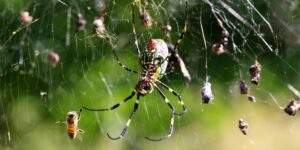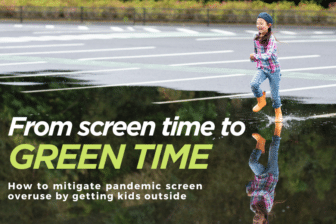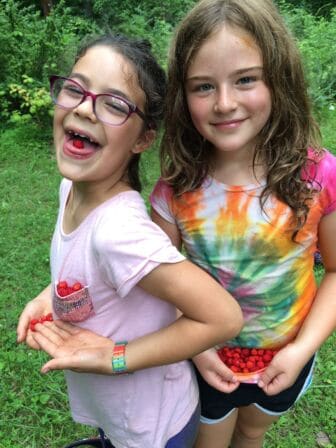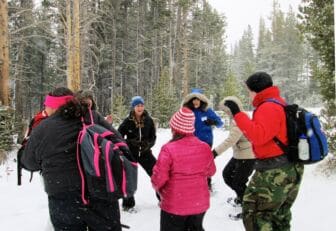Sometimes, I imagine Big Tech as if it were a conniving spider spinning a wider and stickier web to catch all of us well-intentioned insects. App developers and designers of online platforms painstakingly make choices to keep people online, and for some of us, that comes at the direct expense of time out of doors. The web that Big Tech has spun makes me feel like I can’t go about my normal business without getting caught by screens, much less actually disconnect and get “quality time” with nature. Like a fly trapped in a spider’s web, I can’t disentangle myself, and all that screen time drains me.

 After attending the Children’s Screen Time Action Network’s phenomenal webinar with José González, Sharon Danks, and Richard Louv, From green time to screen time: How to mitigate the pandemic screen overuse by getting kids outside, I couldn’t stop thinking about our friend Bill Softky’s article on the principles of neuroplasticity and learning. Bill writes “Brains work best hooked directly to the senses, with time to digest.” To truly challenge the power of Big Tech’s schemes to keep us glued to our screens, we need to get outside, engage our senses, and take some cues from the natural world around us.
After attending the Children’s Screen Time Action Network’s phenomenal webinar with José González, Sharon Danks, and Richard Louv, From green time to screen time: How to mitigate the pandemic screen overuse by getting kids outside, I couldn’t stop thinking about our friend Bill Softky’s article on the principles of neuroplasticity and learning. Bill writes “Brains work best hooked directly to the senses, with time to digest.” To truly challenge the power of Big Tech’s schemes to keep us glued to our screens, we need to get outside, engage our senses, and take some cues from the natural world around us.

As a former outdoor educator and naturalist, I’ve supervised kids who are unfamiliar with remote nature. There’s little media representation of kids of color or lower class backgrounds adventuring outside. Outdoor gear and food is usually marketed to the “granola crunchy” white outdoorsy demographic. Icky bugs and sticky mud and poison ivy vines can leave you poked and itching. With all of that sowing doubt in some kids’ minds, it’s not hard to see why becoming absorbed in a screen can seem like the better option.
But a trusted guide can show kids how to feel more safe and comfortable outside. Knowing which berries to snack on is empowering and exciting. Seeing how dragonfly nymphs swim around the banks of a stream by streaming water out their butts before they grow wings is not only hilarious, it lets kids access silliness even in discomfort.
One of my favorite ways to gently introduce kids to the woods is through an exercise in biomimicry. Breaking down that word into its etymological roots reveals its two parts: bio (life) and mimic (copy or imitate). Brainstorming together, we would describe characteristics of animals that live in those woods, then mimic those traits. For example: deer can stay really still while their big, round ears quiver and pivot to catch the sound around them.
To mimic deer’s ears, my students and I cup our hands around our ears, first facing our palms forward, then backwards. Because the added surface area of our hands funnels and amplifies sound, we can hear extreme differences in the habitat around us. Cupping our ears behind us essentially turns up the volume on the wind through the trees and birds chirping, while in the other direction, we can better hear all of the river’s gurgles and rushes. The effect is powerful – students ooh and ahh. Just as Richard offers during the webinar, an activity like this achieves the sense of wonder and magic that gives kids a relationship with nature, not just an academic orientation to it. Students immediately begin making predictions about the landscape around us. To my satisfaction, even the students most freaked out by nature can be found quietly testing their deer ears throughout the rest of their field trip.

This activity works so well because it integrates our senses. The embodied experience enables kids to gain a conceptual understanding, not just of one organism, but the organism in the context of its habitat. Screen time, conversely, cuts us off from our senses. The same content (i.e. deer have big rounded ears that amplify sound directionally) presented on a screen will not fully land and settle in the minds of young thinkers. And, kept inside, kids are prevented from simultaneously and collaterally learning other life lessons, as Jose described in the webinar. Outside, kids must learn how to prepare and plan for changes in weather, and can come to understand, physiologically, that their bodies send signals to scratch a bug bite as a protective mechanism to help us excavate any toxin that could have entered through our skin.
The Big Tech spider has been getting stronger during the pandemic, and opportunities to escape its web and get outside seem even harder. It’s tempting to blame the spider itself, to boil this down to a problem of just the screens.
By spending time in nature, ecologists have learned that if one species or organism is out-competing others, it’s likely because something in their habitat has shifted. Perhaps more food resources are in abundance, or a more protected shelter becomes available.
If we look at the problem of screen time overpowering green time through the lens of competition, it allows us to zoom out and see that this is an issue of resource management and investment. We can’t just look at the spider itself – we need to look at that organism in its context. Schools are allocating already limited funds for Chromebooks, iPads, and software licenses instead of rainboots and coats. The government is using public funds to build out online pre-kindergarten, instead of building green school yards. With all these available resources, it’s no wonder that screen time has grown so large, even as it can only serve inferior, flattened, learning experiences that cut us off from our senses.
We, the flies and mosquitos doing our best to avoid becoming entirely sucked into the spider’s web, cannot compete with the Big Tech spiders in the habitat as it currently is. But a coordinated movement of students, school leaders, technology directors, city councillors, and families, can help rebalance the habitat – to better resource ourselves with protections and defense mechanisms, while curbing the growth of the Big Tech spider.
Grown-ups, too, stand to learn a lot from biomimicry. As Sharon poignantly shared, we need need to advocate for outdoor equipment to be considered part of school infrastructure, the way desks and computers are considered a necessity. We need to demand resources like green school yards, and parks where people feel safe and connected enough to steward the land. We need to develop defense mechanisms, like avenues to hold Big Tech accountable when they manipulate us. That’s why we’re pursuing more rulemaking authority through the FTC. And, we need protections from policy, like the newly introduced Kids PRIVCY Act.
Shifting the habitat is not something any individual can take on alone. If you’re feeling overwhelmed about how take first steps, get some green time! Disconnected from your screens, engaged with your senses, and curious with questions, you’re nearly guaranteed to end up inspired.

ABOUT THE AUTHOR
Prior to joining Fairplay as the Program Coordinator, Naomi Roswell worked as an environmental educator and naturalist. Each image in this blog was taken during one of her programs.